
 |
||||||
|
GAY
FILM REVIEWS BY MICHAEL D. KLEMM
|
||||||
|
The Watermelon Woman First
Run Features, Director/Screenplay:
Starring:
Unrated, 83 minutes |
Color
Blind
There were many "firsts" in the annals of independent Queer Cinema and Cheryl Dunye's The Watermelon Woman (1996) was the first feature film to be directed by a lesbian of color and the first to specifically address the lives of her African American Sapphic sisters. Due in no small part, I'm sure, to Dunye's cheeky approach to her subject, the film is still fresh and vibrant more than ten years later. The Watermelon Woman won the Teddy Bear for best film at the Berlin International Film Festival |
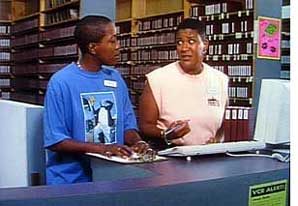 A
free-spirited black video store clerk named Cheryl, played by Dunye, harbors
aspirations of becoming a documentary filmmaker. In the meantime, she supplements
her income by videotaping weddings with her best friend, and co-worker,
Tamara (Valarie Walker). Setting the tone for what is to come, the two are
filming the outdoor nuptials of a black groom and his white bride whose
families ignore each other from opposite sides of the yard. They put their
own creative stamp on the video by inter-cutting images of urban blight. A
free-spirited black video store clerk named Cheryl, played by Dunye, harbors
aspirations of becoming a documentary filmmaker. In the meantime, she supplements
her income by videotaping weddings with her best friend, and co-worker,
Tamara (Valarie Walker). Setting the tone for what is to come, the two are
filming the outdoor nuptials of a black groom and his white bride whose
families ignore each other from opposite sides of the yard. They put their
own creative stamp on the video by inter-cutting images of urban blight. |
|
|
|
|
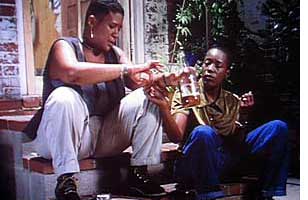 The
Watermelon Woman
is a refreshing film that skewers the treatment of black actors during the
"Golden Age" of Hollywood when their roles were usually confined to playing
the domestic help. Its other big theme involves inter-racial romance and
the prejudice that still comes with it when Cheryl's friends show disapproval
because she isn't dating a "black sister" - the irony here, of course, being
the inability of the lesbian "sisters" to accept someone who doesn't fulfill
their other meaning of "sister" (black). The
Watermelon Woman
is a refreshing film that skewers the treatment of black actors during the
"Golden Age" of Hollywood when their roles were usually confined to playing
the domestic help. Its other big theme involves inter-racial romance and
the prejudice that still comes with it when Cheryl's friends show disapproval
because she isn't dating a "black sister" - the irony here, of course, being
the inability of the lesbian "sisters" to accept someone who doesn't fulfill
their other meaning of "sister" (black). |
|
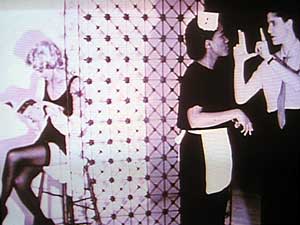 Cheryl
strikes gold on many of the leads that she follows while others turn up
as dead ends. Her mother's old friend, an unmarried and retired factory
worker, remembers seeing Fae perform at many colored nightclubs and tells
Cheryl that Fae "sang for all us stone butches." Controversial culture critic
Camille Pagila complains of the way modern black scholarship looks at the
films of the 30s and calls Hattie McDaniel in Gone With The Wind
an earth goddess. Cheryl visits C.L.I.T. (the Center For Lesbian Info &
Technology), a "volunteer collective" in which all of their archival material
lies unorganized in boxes. "We received a very generous gift from the Hysteria
Collection," the curator tells Cheryl, "But they wanted it to be used exclusively
for African American lesbians so if we have any photographs in which there
are white people, then we just cross them out." Martha Page's surviving
sister is of no use because she refuses to accept reality and admit that
her sibling was a lesbian. Cheryl
strikes gold on many of the leads that she follows while others turn up
as dead ends. Her mother's old friend, an unmarried and retired factory
worker, remembers seeing Fae perform at many colored nightclubs and tells
Cheryl that Fae "sang for all us stone butches." Controversial culture critic
Camille Pagila complains of the way modern black scholarship looks at the
films of the 30s and calls Hattie McDaniel in Gone With The Wind
an earth goddess. Cheryl visits C.L.I.T. (the Center For Lesbian Info &
Technology), a "volunteer collective" in which all of their archival material
lies unorganized in boxes. "We received a very generous gift from the Hysteria
Collection," the curator tells Cheryl, "But they wanted it to be used exclusively
for African American lesbians so if we have any photographs in which there
are white people, then we just cross them out." Martha Page's surviving
sister is of no use because she refuses to accept reality and admit that
her sibling was a lesbian. |
|
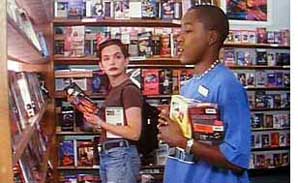 For
the most part, the tone of The Watermelon Woman
is comic and hits all the right satiric notes. Consider the rapid-fire and
outrageously clue-less discourse delivered by Camille Pagila during her
interview segment. (I am assuming that she was deliberately indulging in
self parody here and poking fun at her own background in feminist and cultural
studies, not to mention her legendary talent for pissing people off.) For
the most part, the tone of The Watermelon Woman
is comic and hits all the right satiric notes. Consider the rapid-fire and
outrageously clue-less discourse delivered by Camille Pagila during her
interview segment. (I am assuming that she was deliberately indulging in
self parody here and poking fun at her own background in feminist and cultural
studies, not to mention her legendary talent for pissing people off.) |
|
|
|
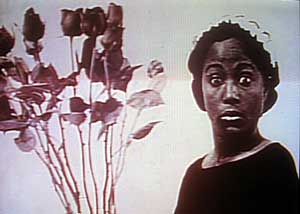 Dunye
must have had a blast playing with filmic cliches and racial stereotypes
while she and her art directors created the old, scratchy film parodies
and faded photographs. The clip from Plantation Memories in which
the Watermelon Woman comforts her white mistress, as a lush string arrangement
of "My Old Kentucky Home" drones in the background, is so deliberately cliched
and offensive that it cannot help but induce belly laughs. Ditto for the
other "race films" that Cheryl watches. "I can barely stand the stuff Hollywood
puts out now," says Tamara, "Let alone that nigger-mammy shit from
the 30s." Dunye
must have had a blast playing with filmic cliches and racial stereotypes
while she and her art directors created the old, scratchy film parodies
and faded photographs. The clip from Plantation Memories in which
the Watermelon Woman comforts her white mistress, as a lush string arrangement
of "My Old Kentucky Home" drones in the background, is so deliberately cliched
and offensive that it cannot help but induce belly laughs. Ditto for the
other "race films" that Cheryl watches. "I can barely stand the stuff Hollywood
puts out now," says Tamara, "Let alone that nigger-mammy shit from
the 30s." |
|
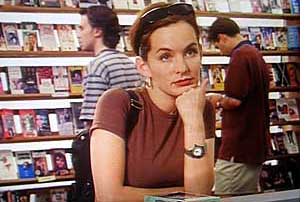 The
brassy Tamara, it turns out, could learn a bit of tolerance herself. While
arguing about Cheryl's white lady friend, her sassy attitude colors their
flip dialogues. Tamara accuses Diana of being a white girl who wants to
be black and asks Cheryl why she is ashamed of her own skin color. Cheryl
wants nothing to do with Yvette, the dippy black sister that Tamara keeps
trying to fix her up with. We meet Yvette in an early scene at a karaoke
bar where, dressed like a 20s flapper with a cigarette in a holder, she
sashays up to the microphone to mangle that old Minnie Ripperton chestnut,
"Loving You." The
brassy Tamara, it turns out, could learn a bit of tolerance herself. While
arguing about Cheryl's white lady friend, her sassy attitude colors their
flip dialogues. Tamara accuses Diana of being a white girl who wants to
be black and asks Cheryl why she is ashamed of her own skin color. Cheryl
wants nothing to do with Yvette, the dippy black sister that Tamara keeps
trying to fix her up with. We meet Yvette in an early scene at a karaoke
bar where, dressed like a 20s flapper with a cigarette in a holder, she
sashays up to the microphone to mangle that old Minnie Ripperton chestnut,
"Loving You." |
|
 Most
interesting of all is the way the faux-history of Fae Richards comes to
life and one almost wishes that this wasn't a mockumentary and that
the Watermelon Woman really existed. (As Dunye says at the film's conclusion:
"We create our own identity.") Though fabricated, the old film
clips and photographs are utterly convincing. Using a few actual archive
clips of the colored nightclub scene help blur the line even further. The
very questions of identity are further confused as this is a work of fiction
yet Cheryl Dunye, her mother and Camille Paglia appear as themselves. Consider
another scene too in which identity is skewed when two racial-profiling
police officers - one white and one black - mistake the butchly dressed
Cheryl for a young street thug and assume her video camera is stolen property. Most
interesting of all is the way the faux-history of Fae Richards comes to
life and one almost wishes that this wasn't a mockumentary and that
the Watermelon Woman really existed. (As Dunye says at the film's conclusion:
"We create our own identity.") Though fabricated, the old film
clips and photographs are utterly convincing. Using a few actual archive
clips of the colored nightclub scene help blur the line even further. The
very questions of identity are further confused as this is a work of fiction
yet Cheryl Dunye, her mother and Camille Paglia appear as themselves. Consider
another scene too in which identity is skewed when two racial-profiling
police officers - one white and one black - mistake the butchly dressed
Cheryl for a young street thug and assume her video camera is stolen property. |
|
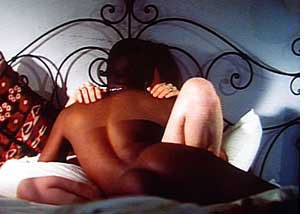 Finally,
there is Cheryl's romance with Diana. While not the film's main focus, there
are genuine sparks between these two ladies and their love story is probably
one of the sexiest in all of lesbian cinema. Their love scenes involve a
lot of tongues and will certainly please those in the audience who like
a little spice. Their steamy sexual interlude provoked outrage from the
same conservative Congressmen who seem to have nothing better to do with
their time besides bitch about how money from the National Endowment For
The Arts is being spent - putting The Watermelon
Woman in the same esteemed company as Todd Haynes' Poison,
performance artists Tim Miller and Holly Hughes, and a certain Robert Mapplethorpe
art exhibition. (Dunye's website reports that Senator Jesse Helms called
the film, "flotsam floating down a sewer." I'm sure that the inter-racial
aspect to the sex really got their knickers in a twist.) Finally,
there is Cheryl's romance with Diana. While not the film's main focus, there
are genuine sparks between these two ladies and their love story is probably
one of the sexiest in all of lesbian cinema. Their love scenes involve a
lot of tongues and will certainly please those in the audience who like
a little spice. Their steamy sexual interlude provoked outrage from the
same conservative Congressmen who seem to have nothing better to do with
their time besides bitch about how money from the National Endowment For
The Arts is being spent - putting The Watermelon
Woman in the same esteemed company as Todd Haynes' Poison,
performance artists Tim Miller and Holly Hughes, and a certain Robert Mapplethorpe
art exhibition. (Dunye's website reports that Senator Jesse Helms called
the film, "flotsam floating down a sewer." I'm sure that the inter-racial
aspect to the sex really got their knickers in a twist.) |
|
|
The DVD also includes the interview with Dunye that appears in the 1996 documentary, Lavender Limelight. This is a great film, check it out.
Guinevere Turner
and V.S. Brodie also appear in: Guinevere Turner
also appear in: |